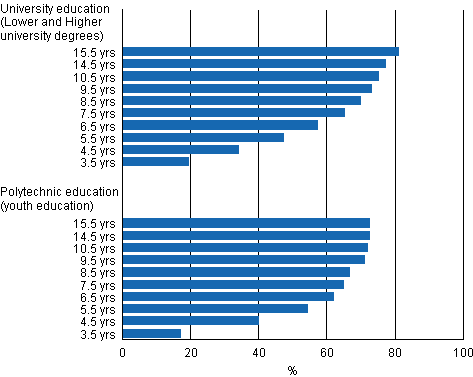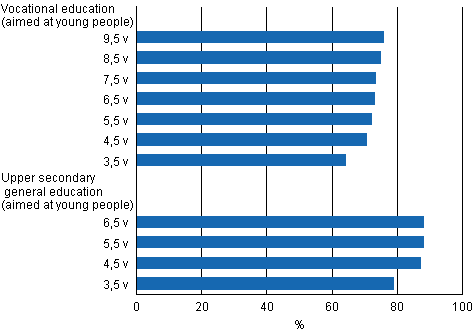Published: 20 March 2012
Women graduated from universities faster than men
According to Statistics Finland, a university degree was completed by 47 per cent of students in about five-and-a-half years, by 58 per cent of women and 34 per cent of men. Polytechnic education was passed in four-and-a-half years by 40 per cent of students, by 54 per cent of women and 24 per cent of men. The pass rate for upper secondary general education was on level with the previous year. In other sectors of education the pass rate improved from the year before.
Pass rates for university and polytechnic education in different reference periods by the end of 2010

These statistics examine the situation at the end of 2010 of students having started vocational education or upper secondary general education aimed at young people in 2007, polytechnic education for young people in 2006 and university education in 2005.
Pass rates for vocational and upper secondary general education in different reference periods by the end of 2010

The pass rate for a university degree in five-and-a-half years was 47 per cent. Included are both those completing a lower and higher university degree. As a rule, all students complete a lower university degree before a higher university degree. A higher university degree was completed by 19 per cent and a lower university degree by 28 per cent. In polytechnic education aimed at young people, 40 per cent attained a degree in four-and-a-half years, close on one percentage point more than one year previously. Initial vocational education was passed by 64 per cent and matriculation examination by 79 per cent of those having started to study for it three-and-a-half years earlier. The pass rate for vocational education improved by close on one percentage point, and the pass rate for passers of the matriculation examination was the same as one year before.
Among women the pass rate is higher than men's level in all sectors of education except for vocational education. Women's pass rate was one percentage point higher than men's in upper secondary general education and one percentage point lower in vocational education. The differences in pass rates between men and women were considerably bigger in tertiary level education. Fifty-four per cent of women and 24 per cent of men attained a polytechnic degree. A lower or higher university degree was completed by 58 per cent of women and 34 per cent of men. The differences between the pass rates even out somewhat over a longer time period. For example, 87 per cent of women and 75 per cent of men attained a lower or higher university degree within 15 years.
In all sectors of education there are big field-specific differences in the pass rates (see Tables in databases). Tertiary level degrees were completed at universities in relative terms the most by students in the fields of humanities and education and the least by students in the field of natural sciences. In polytechnic education the highest pass rate of 64 per cent was achieved in the field of health, welfare and sports. At 22 per cent, the pass rate was the lowest in the field of technology and transport. In vocational education nearly all had attained a qualification in the fields of safety and security (other education: firefighter, police). The next highest pass rates were in the field of welfare, health and sports and in the fields of humanities and education, in which a vocational qualification had been attained in the respective field by 68 per cent of students. The pass rate was the lowest in the field of natural sciences, at 48 per cent.
The tables in databases for these statistics include information on those students who did not attain their qualification in the target time. Information related to studying is also available from the statistics describing Discontinuation of education and Employment of students .
Source: Education Statistics 2012, Statistics Finland
Inquiries: Anna Loukkola 09 1734 3678, koulutustilastot@stat.fi
Director in charge: Jari Tarkoma
Publication in pdf-format (242.4 kB)
- Tables
-
Tables in databases
Pick the data you need into tables, view the data as graphs, or download the data for your use.
Appendix tables
- Appendix table 1. Progress of new upper secondary school students (aimed at young people) studies by end 2010 (20.3.2012)
- Appendix table 2. Progress of new students studies in vocational education (aimed at young people) by end 2010 (20.3.2012)
- Appendix table 3. Progress of new polytechnic students studies by end 2010, youth education (20.3.2012)
- Appendix table 4. Progress of new university students studies by end 2010, lower or higher university degrees (20.3.2012)
Updated 20.3.2012
Official Statistics of Finland (OSF):
Progress of studies [e-publication].
ISSN=1799-1021. 2010. Helsinki: Statistics Finland [referred: 7.1.2026].
Access method: http://stat.fi/til/opku/2010/opku_2010_2012-03-20_tie_001_en.html

